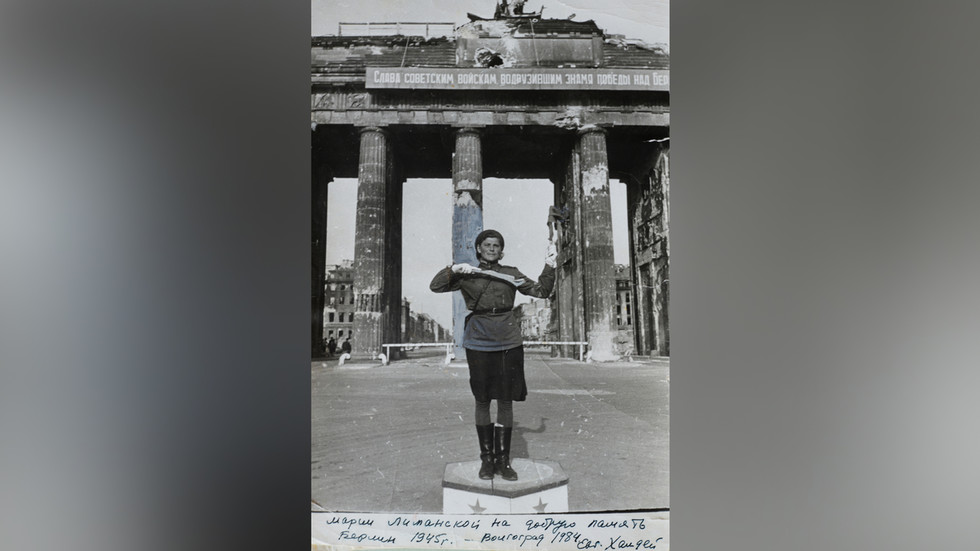The Passing of a Symbol: Remembering the Woman Behind the Iconic Berlin Victory Photograph
In the annals of World War II history, certain images have transcended time, encapsulating the essence of pivotal moments. One such photograph is that of a young Soviet traffic controller standing resolutely amidst the ruins of Berlin, a symbol of triumph and resilience. The recent passing of Maria Limanskaya, the woman immortalized in this iconic image, at the age of 100, marks the end of an era and invites reflection on her remarkable life and the enduring legacy of that moment.
A Life Intertwined with History
Born in 1924, Maria Limanskaya’s early years were shaped by the tumultuous events of the early 20th century. As the Second World War engulfed Europe, she joined the Soviet forces, contributing to the war effort in various capacities. Her role as a traffic controller brought her to the heart of Berlin in May 1945, just as the city was surrendering to Allied forces.
It was during this period that Yevgeny Khaldei, a photojournalist for the TASS news agency, captured the image that would define Limanskaya’s legacy. Standing at the Brandenburg Gate, directing the flow of military vehicles and personnel, she embodied the Soviet victory over Nazi Germany. This photograph, widely disseminated, became a symbol of the Allies’ triumph and the resilience of those who served.
The Iconography of Victory
The photograph of Limanskaya is more than a mere snapshot; it is a powerful piece of wartime iconography. The backdrop of the Brandenburg Gate, a historic symbol of Berlin, juxtaposed with the presence of a Soviet female soldier, conveyed a narrative of liberation and the shifting tides of power. The image resonated not only within the Soviet Union but also globally, representing the end of a devastating conflict and the hope for a new beginning.
Such images play a crucial role in shaping public perception and collective memory. They distill complex events into singular, relatable moments, allowing individuals to connect with history on a personal level. Limanskaya’s photograph serves as a testament to the countless women who contributed to the war effort, often in roles that defied traditional gender norms.
Post-War Life and Legacy
After the war, Maria Limanskaya returned to civilian life, her wartime service a source of personal pride and public recognition. She remained relatively private, yet her image continued to inspire. In 1984, nearly four decades after the photograph was taken, Limanskaya reunited with Khaldei, the photographer, for a commemorative portrait. This reunion highlighted the enduring bond between subject and artist, and the lasting impact of their shared moment in history.
Limanskaya’s centennial life spanned a century of profound change. Her experiences during the war and the subsequent years reflect the resilience and adaptability of a generation that witnessed both the depths of human conflict and the heights of human achievement.
Women in Wartime: Unsung Heroes
Maria Limanskaya’s story is emblematic of the broader, often underrepresented narrative of women’s contributions during World War II. Across nations, women stepped into roles traditionally held by men, serving as nurses, factory workers, intelligence agents, and, as in Limanskaya’s case, military personnel. Their efforts were indispensable to the war effort and laid the groundwork for subsequent movements toward gender equality.
In the Soviet Union, women constituted a significant portion of the workforce and military. They served as pilots, snipers, and partisans, with many receiving commendations for their bravery. However, their stories have frequently been overshadowed by those of their male counterparts. Recognizing figures like Limanskaya helps to rectify this historical oversight and honors the full spectrum of contributions made during the war.
The Power of Photography in Shaping Historical Memory
The photograph of Maria Limanskaya at the Brandenburg Gate exemplifies the profound impact of visual media in documenting and interpreting history. Photographs serve as tangible links to the past, capturing moments that words alone cannot fully convey. They have the power to evoke emotions, provoke thought, and inspire action.
Yevgeny Khaldei’s work, including the famous “Raising a Flag over the Reichstag,” played a pivotal role in crafting the visual narrative of Soviet victory. These images were not merely documentary; they were instrumental in shaping the collective memory of the war and the perception of Soviet heroism. The photograph of Limanskaya stands alongside these iconic images, a testament to the enduring power of photography.
Commemorating a Century of Resilience
As we reflect on the life of Maria Limanskaya, we honor not only her individual contributions but also the broader legacy of those who served during World War II. Her image remains a symbol of resilience, courage, and the enduring human spirit. In commemorating her passing, we are reminded of the importance of preserving these stories and ensuring that future generations understand the sacrifices made in the pursuit of peace.
Maria Limanskaya’s centennial journey, immortalized in a single photograph, continues to inspire and remind us of the profound impact that one life can have on the tapestry of history.
See more CNET 247



